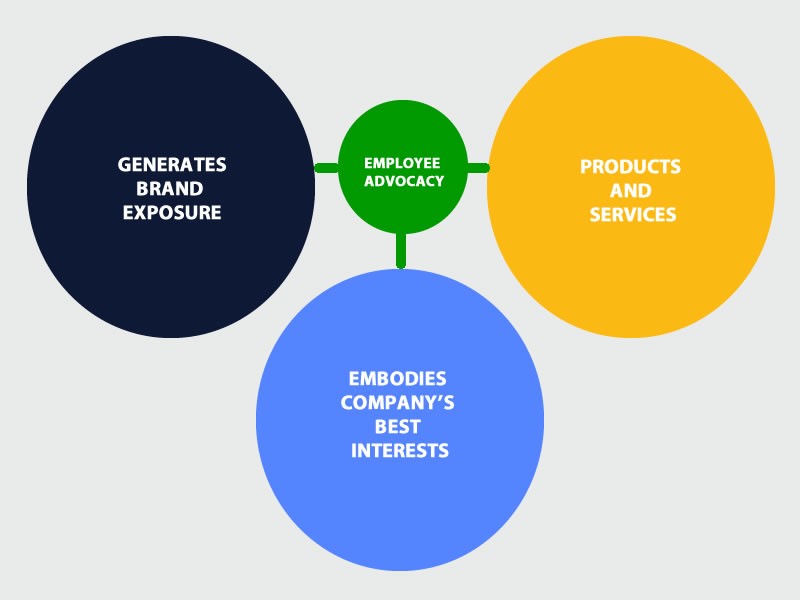Insight Blog
Agility’s perspectives on transforming the employee's experience throughout remote transformation using connected enterprise tools.
9 minutes reading time
(1704 words)
Employee Brand Advocacy: What Is Employee Advocacy & How Does It Really Work?
Despite Employee Brand Advocacy growing popularity, a majority of brands have yet to truly activate employees as marketing, sales, or recruiting assets.
A common form of current company marketing is brand advocacy. Word-of-mouth advertising is used by brand advocates to promote the company. Their positive feedback on the company's products or services aids in attracting new clients. By putting goods on their social media pages, brand advocates help generate new material for the company.
- What is Brand advocacy: Brand advocacy piques people's interest in your product or service both inside and beyond the company.
- Who are the Brand advocates: Employees, customers, and influencers can all be brand advocates. They disseminate information about a brand far more quickly than paid advertising.
Using employees as brand advocates to tell the world more about the amazing firm they work for and the fantastic products it generates can be an effective persuasion strategy.
This method is effective for both recruiting and selling. A nice word from an employee about the benefits they receive, their flexible hours, or a tasty new ice cream flavor their company has introduced is a powerful marketing tool.
Brands can no longer depend on paper advertising in the digital world we live and work in. The most successful method of communication that most people use on a regular basis is social media. When was the last time you went through your messages, notifications, or newsfeed? Isn't it only a few hours ago? People nowadays are constantly monitoring their smartphones to ensure that they do not miss anything that may damage them.
One strategy to increase brand advocacy is to add a company intranet. It might include brand advocacy apps to encourage employees to like and share information from both inside and outside the organization.
Customer Brand Advocacy
Brand supporters are 50 percent more likely to influence a purchase, according to marketing research. This could be done by word-of-mouth or through the use of digital media.
When we buy or have a positive experience with anything, we tell our friends and family about it, which keeps people interested in the product or service. Cellphones and other forms of technology are frequently used as promotional tools. It's so simple to share the link with friends or a group if you went to a fantastic restaurant last week. Then three of those people eat at the cafe and share the link with their friends, and so on... This is how it works with brand advocacy.
In the same way, influencer marketing works. Sharing a photo of a product or the company's logo on Instagram or Twitter plants a seed to draw attention to the brand if you receive outstanding customer service. This type of social mention can increase sales and is one of the simplest instances of brand advocacy. The key is to react quickly, stay engaged, and form bonds with others.
Why is Brand Advocacy so Important for Companies?
Brand advocacy can help a business stand out from the competition. It's a strong public relations machine that works for a wide range of businesses, from B2B firms to non-profits. The perception of a brand is crucial to its success. This is aided by brand advocacy.
Here are some reasons why brand advocacy is extremely important:
1.Keeps a Company Ahead of the Competition
Being the brand that everybody is talking about because of a new product or memorable advertising campaign keeps a company ahead of the competition.
2.Encourages Customer Loyalty
Customers who are loyal come back and buy again. They bring up the brand in conversations and have an impact on how and what people buy.
3.Builds Trust
To create a brand advocate, you must first earn people's trust. When someone has faith in a firm, they believe in its ideals and how it treats its customers.
4.Boosts Content Creation
Without recognizing it, advocates serve as marketers for a company. They are providing the business free publicity every time they post a video or share an article. Inviting guests to contribute to a blog can be a powerful marketing technique for increasing company awareness.
5.Promotes Business Growth
Every new transaction generates additional profit, therefore brand advocates have an indirect impact on corporate growth. Although difficult to quantify, subtle marketing should be included in marketing plans because it is just as vital as standard marketing.
6.Help Find New Audiences
There is a target market for brand marketing. But what if your target market is already occupied? How does a business get new customers? Brand advocacy can reach new audiences who aren't always in the target demographic. Smartphone advertising, for example, is targeted at a specific age range. Outsiders may be persuaded to purchase a smartphone if a trusted friend or colleague talks about it.
Tips on how to create a very Successful Brand Advocacy Program
Marketing tactics should incorporate a brand advocacy program. It should apply to both internal and external stakeholders. This is your chance to instill enthusiasm for your business and develop something unique. But how do you go about putting such brand advocacy programs?
1. Define your Advocates
It's impossible to leave employee advocacy to chance. Determine who your brand's supporters are among your client and employee base, as these people are loyal to your brand. You can accomplish this by looking at who comments on your posts. These individuals will assist you in enhancing your brand's image. Take care of your supporters and provide them with rewards and incentives to keep them engaged.
2. Make Sharing Posts Easy
In today's digital age, everyone is extremely busy. How many times have you put off reading an article or seen an item you want to buy until later? But you didn't have the time, forgot about it, and went on to something else in the meanwhile. When someone reads your text, make it simple for them to like, share, or repost it. To do so, find the best brand advocacy software for your intranet and website that is simple to use, cost-effective, and dependable.
3. Be Consistent
A strong presence transforms a company into one that people trust. If you write a blog article or a special deal every day, people will know you're genuine and care about what they have to say. They're more likely to follow you and look forward to your daily posts. Customers want to feel protected when they spend money, and a trustworthy company fosters that feeling.
4. Create Promotions
Everyone enjoys a good deal. Make special and best deals plans and discounts a part of your brand advocacy plan. You've got a winning recipe for encouraging people to support you if you combine referral systems, awards, competitions, and introductory deals.
5. Listen to Your Employees and Customers
Everyone enjoys a good deal. Make special deals and discounts a part of your brand advocacy plan. You've got a winning recipe for encouraging people to support you if you combine referral systems, awards, competitions, and introductory deals. Customers and workers become champions as a result of this because they believe their voice matters. You can also do this with a comment section — just be sure to respond to remarks as soon as possible.
6. Be Real and Approachable
How many times have you left a website because it was chilly and uninteresting? Nobody wants to make a purchase from a website that is unfriendly. People prefer to see the actual person with whom they are interacting. This entails putting bios of your managers and team leaders up on the bulletin board. This can be a lengthy profile that employees fill out on an intranet so that their colleagues can learn more about them. Being genuine builds trust, which in turn leads to advocacy.
7. Set Goals
Set measurable and time-bound objectives. For example, in the following three months, raise intranet post shares by 50 percent, or reach a certain number of Twitter mentions for a new product launch.
How do You Measure Your Brand Advocacy?
It's critical to track the success of your brand advocacy program in order to justify any expenditures and identify areas for improvement. The following are the criteria for determining brand advocacy:
1.Review Goals
Examine your objectives carefully to see if they're attainable. Keep going through them to see what works and what doesn't in terms of social media marketing.
2.Consider your Platform
Is your intranet or website providing you with the data you require? Can it track and record views, likes, postings, and other data and show it in a logical manner? In order to evaluate your brand advocacy initiatives, you'll need a reliable reporting platform. A solid platform:
- Is it simple to use?
- Has an easy-to-use dashboard
- Modifications are possible to match your needs.
- There are obvious reporting tools included.
3.Track and Collect Data
When it comes to measuring your brand advocacy, the manner you track views and likes on a blog post or article is critical. This includes the following:
- What reach you're achieving
- Who is liking/sharing a post?
- Which campaigns work the best like Facebook, Instagram, Twitter, etc?
You'll be able to tell if your advocates are engaged with your brand based on the findings. Is there a pattern to the "likes" you're getting, or are they just random? For example, you might discover that your Facebook posts aren't performing as well as you had hoped. Is it possible that your product isn't a good fit for your platform's advocates? These types of responses can help you make an impact with your brand and engage the people who are most likely to be interested in it.
4.Keep Measuring
Keeping track of brand advocacy is a long-term approach to incorporate into your marketing plan. This type of organic marketing is becoming more popular, therefore it's critical to maintain track of brand advocacy outcomes on a regular basis to stay ahead of the curve.
It's also crucial to consider who your champions are and whether they're right for your target market. Your brand advocates will grow as your company grows.
Categories
Blog
(2572)
Business Management
(315)
Employee Engagement
(204)
Digital Transformation
(171)
Intranets
(119)
Growth
(115)
Remote Work
(61)
Sales
(48)
Collaboration
(37)
Culture
(29)
Project management
(29)
Customer Experience
(25)
Knowledge Management
(21)
Leadership
(20)
Comparisons
(5)
Ready to learn more? 👍
One platform to optimize, manage and track all of your teams. Your new digital workplace is a click away. 🚀
Free for 14 days, no credit card required.















